Letar du efter lätta skidor som gör uppförsbackar enklare och nedförsåk roligare? Oavsett om du gillar skidbestigning, fitnessrundor eller äventyr i orörd terräng, kan rätt utrustning göra hela skillnaden. Här är vad du behöver veta:
- Snowfeet* erbjuder kompakta, lätta skidor som WALKSKI (100 cm) och NORDIC (90 cm). Dessa är utmärkta för portabilitet, enkla övergångar och användning med vanliga vinterkängor. Perfekta för nybörjare eller fitnessentusiaster. Priserna börjar runt 490 dollar.
- Traditionella turåksskidor (som Atomic Backland 86 UL, Blizzard Zero G 105, K2 Wayback 89 och Salomon MTN 86 Pro) fokuserar på nedförsprestation. De är längre, tyngre och kräver specialiserade pjäxor och bindningar. Kostnaderna varierar från 600 till 2 500 dollar för kompletta set.
Snabb sammanfattning:
- Vill du ha enkla, portabla och nybörjarvänliga skidor? Välj Snowfeet*.
- Jagar du branta nedförskänslor? Traditionella skidor kan vara ditt val, men de är dyrare och tyngre.
Snabb jämförelse:
| Modell | Längd | Kängtyp | Bäst för | Prisklass |
|---|---|---|---|---|
| Snowfeet* WALKSKI | 100 cm | Vanliga vinterkängor | Fitnessrundor, måttliga nedförsbackar | ~$490 |
| Snowfeet* NORDIC | 90 cm | Vanliga vinterkängor | Fitness-träning, trång terräng | ~$490 |
| Atomic Backland 86 UL | 149–177 cm | Specialiserade AT-pjäxor | Aggressiva utförsåkningar | $600–$2,000 |
| Blizzard Zero G 105 | 180–188 cm | Specialiserade AT-pjäxor | Branta, högfartsnedfarter | $700–$2,500 |
| K2 Wayback 89 | 180+ cm | Specialiserade AT-pjäxor | Öppet terräng, puder | ~$750 |
| Salomon MTN 86 Pro | 160–180 cm | Specialiserade AT-pjäxor | Blandade förhållanden, utför | ~$800+ |
Snowfeet* skidor prioriterar portabilitet och enkel användning, medan traditionella set fokuserar på stabilitet och avancerad utförsprestation. Välj efter dina mål!
Den bästa utrustningen för skidturer 2025
1. Snowfeet* WALKSKI Backcountry Touring Skis (100 cm)
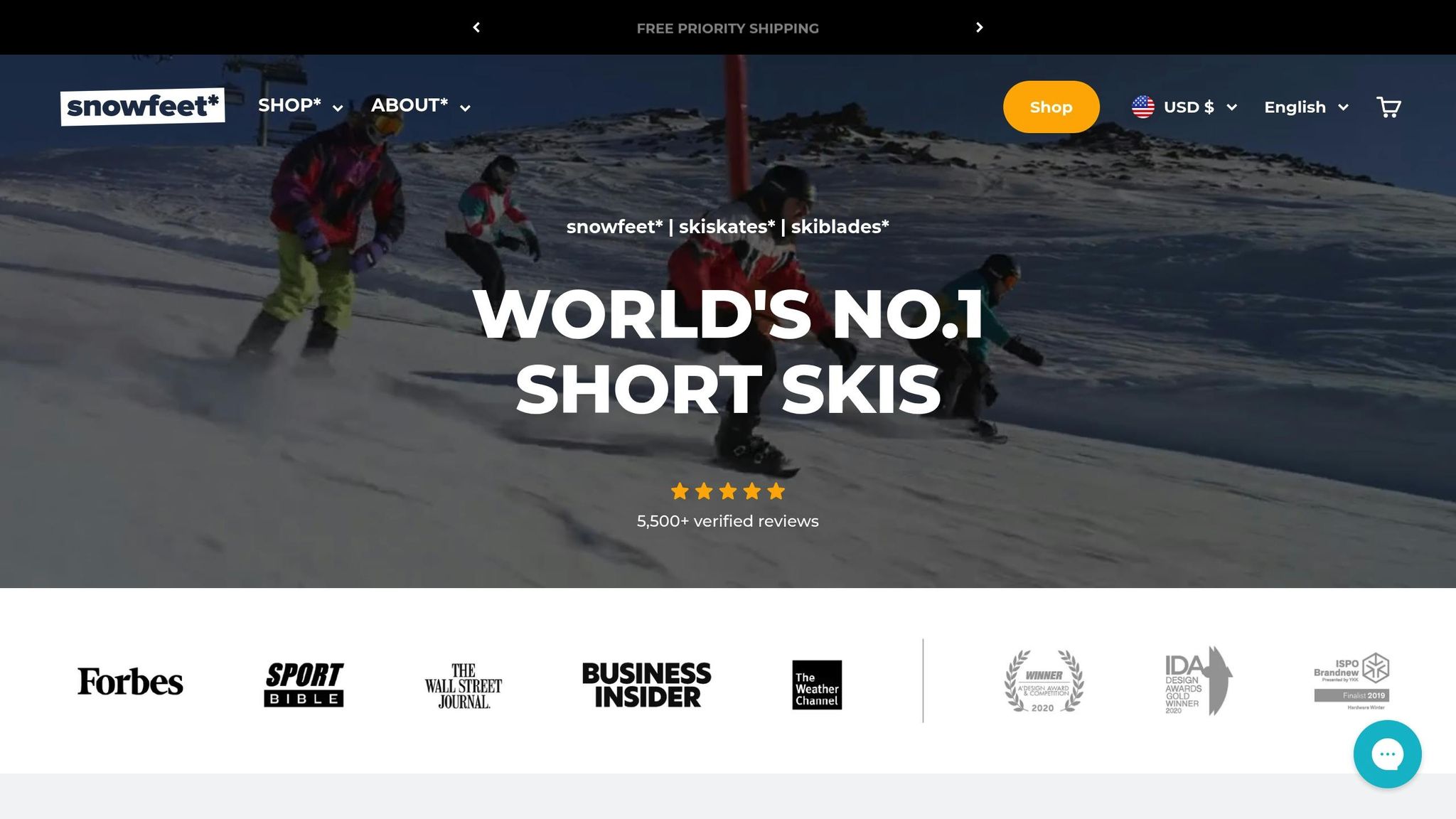
Snowfeet* WALKSKI vänder upp och ner på traditionella turåksskidor. Med bara 100 cm längd fokuserar dessa skidor på portabilitet och bekvämlighet, och bryter med idén att längre alltid är bättre när det gäller fjällskidåkning. Om du letar efter utrustning som är lätt att bära och snabb att byta till kan WALKSKI vara din nya favorit.
Vikt
Tack vare sin kompakta design är WALKSKI betydligt lättare än vanliga turåksskidor. Som jämförelse väger ultralätta modeller som Movement Alp Tracks 106 cirka 2 740 gram per par. Denna lägre vikt innebär mindre belastning på dina ben under de tuffa uppförsbackarna, vilket hjälper dig att spara energi till nedfarten.
Längd
Med 100 cm är dessa skidor i en egen klass. Deras korta längd gör dem otroligt lätta att packa – perfekta för approach-skidåkning eller flerdagars bergsbestigningar. Även om de kanske inte erbjuder samma stabilitet som längre skidor vid hög hastighet eller djup pudersnö, säkerställer deras kompakta storlek utmärkt manövrerbarhet och snabba kant-till-kant-övergångar. Det är en kompromiss som fungerar bra i trånga utrymmen och måttlig terräng.
Pjäxkompatibilitet
En av WALKSKI:s framstående egenskaper är dess fria hälbindningar, som är kompatibla med de flesta vandrings-, trekking- och vinterpjäxor (storlekar 24 cm till 38 cm / 9,5"–15"). Det betyder att du inte behöver specialpjäxor, vilket förenklar din utrustning. Oavsett om du vandrar, klättrar eller åker skidor kan du använda samma par pjäxor, vilket gör din utrustning mer mångsidig och ditt liv mycket enklare.
Prestanda (Uppför/Nedfärd)
WALKSKI:s design glänser både uppför och nedför. Dess lätta konstruktion minskar ansträngningen vid uppförssträckor, även på utmanande stigningar. Kombinera med klisterstegar så får du bra grepp och effektivitet för branta rutter. Nedför ger den kortare längden dig utmärkt kontroll i trånga eller varierande terränger. Även om den inte är byggd för att flyga nerför vidöppna backar i hög hastighet, är den perfekt för fitnessvarv och mer måttliga nedfarter.
Pris
För $490 är WALKSKI ett budgetvänligt alternativ till traditionella turupplägg. För jämförelse kan högkvalitativa ultralätta tur-skidor som Movement Alp Tracks 106 kosta runt $1,100. WALKSKI:s allt-i-ett-design sparar inte bara pengar utan förenklar också övergångarna mellan skid- och gånglägen. Det gör den till ett smart val för fitnessentusiaster och nybörjare inom skidmountaineering som vill ha en enkel och okomplicerad utrustning.
2. Snowfeet* NORDIC längdskate-skidor (90 cm)
Snowfeet* NORDIC ger en ny twist på backcountry fitness genom att kombinera längdskidåkningstekniker med en kompakt, portabel design. Med sina bara 90 cm är dessa skidor perfekta för fitnessentusiaster som värdesätter snabbhet och smidighet framför traditionell utförsåkning.
Vikt
Tack vare sin ultrakompakta design är NORDIC otroligt lätt. Till skillnad från traditionella längdskidåkningstävlingsskidor, som tenderar att vara klumpigare, minskar NORDIC trötthet under längre pass, vilket gör den till ett utmärkt val för längre träningspass.
Längd
Med en längd på 90 cm är NORDIC 10 cm kortare än sin WALKSKI-motsvarighet. Denna kortare längd gör det lättare att manövrera i trånga utrymmen och utföra snabba övergångar. Jämfört med traditionella längdskidor, som ofta överstiger 170 cm, erbjuder NORDIC oöverträffad smidighet, perfekt för fokuserade och effektiva träningspass.
Pjäxkompatibilitet
NORDIC har en universell passform för pjäxor, vilket eliminerar behovet av specialiserade längdpjäxor. Du kan smidigt växla från vandring till skidåkning utan extra krångel, vilket gör det till ett bekvämt alternativ för användare som gillar äventyr med flera aktiviteter.
Medan WALKSKI glänser i fjällturer är NORDIC anpassad för högintensiva fitnessvarv med en urban touch.
Prestanda (Uppför/Nedfärd)
När det gäller uppförsprestation utmärker sig NORDIC. Dess längdskidåkning med skatestil uppmuntrar en mjuk, rytmisk rörelse som inte bara bygger bålstyrka utan också förbättrar konditionen. Den kompakta längden möjliggör snabba steg, idealiskt för intervallträning. På nedförssträckor erbjuder NORDIC precis kontroll, särskilt i smala eller svåra förhållanden. Även om den inte är byggd för högfarts alpina nedfarter hanterar den tekniska, kontrollerade nedfarter med lätthet.
Pris
NORDIC är ett budgetvänligt alternativ inom fitnessskidåkning och erbjuder ett utmärkt alternativ till traditionella längdskidåkningsuppsättningar för tävling. Dess kombination av prestanda och mångsidighet gör den till ett utmärkt val för motionsidrottare och fitnessentusiaster som vill höja sin vinterträning utan att spräcka budgeten.
3. Atomic Backland 86 UL
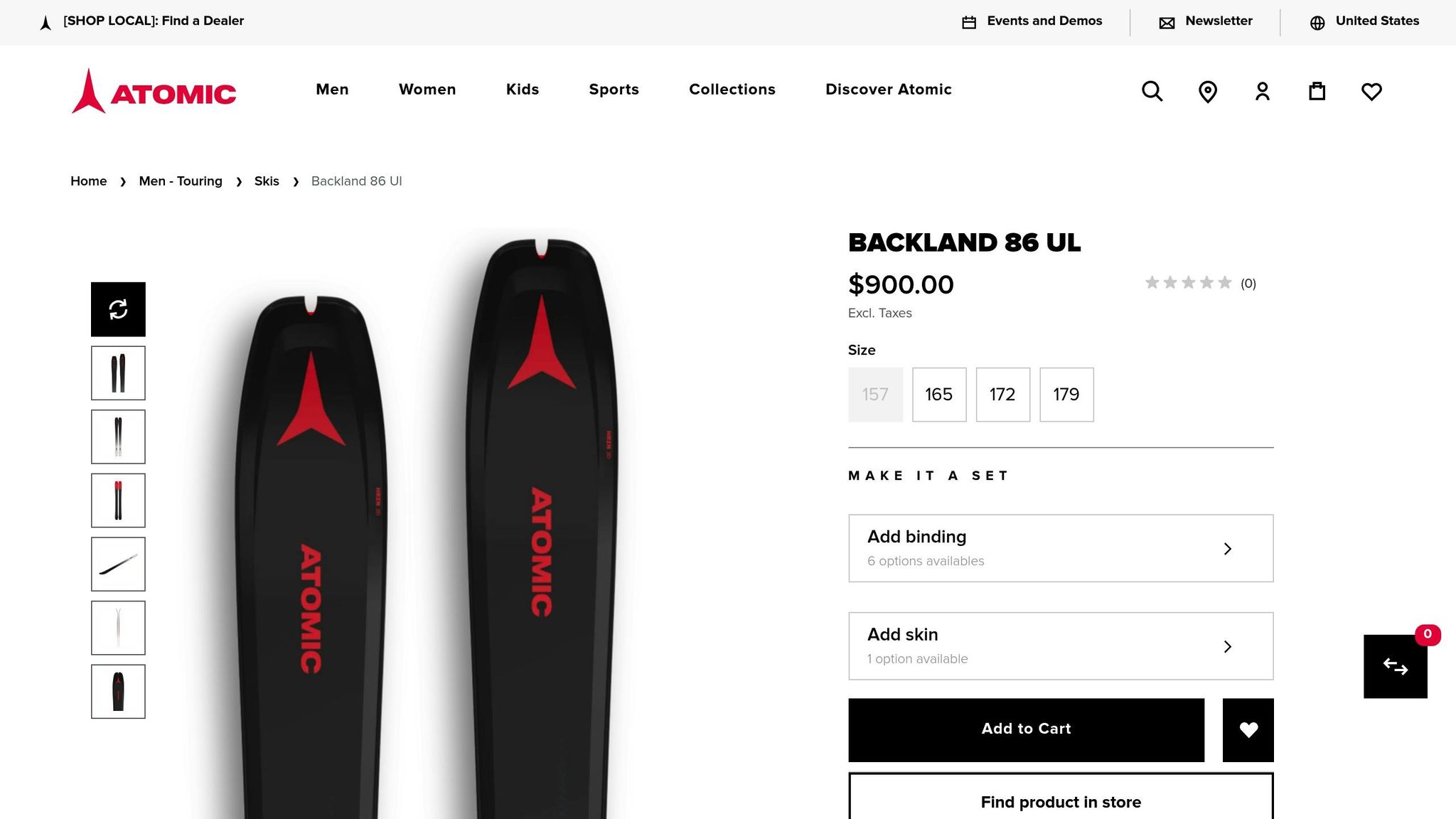
Atomic Backland 86 UL håller sig till en klassisk alpinturdesign. Till skillnad från Snowfeet*-modellerna, som fokuserar på mångsidighet och enkla övergångar, lutar Backland 86 UL åt ett mer traditionellt tillvägagångssätt. Denna kontrast visar varför kompakta designer blir allt mer populära inom modern skidalpinism.
Vikt
Varje Backland 86 UL-skida väger cirka 2,4 pounds, vilket uppfyller ultralätt-standarden för traditionella skidor. Jämfört med kompakta alternativ kan denna vikt dock kännas som en börda på långa uppstigningar. Med traditionella turåkarskidor som dessa måste du förlita dig mer på dina ben och din bål, särskilt under långa uppförssektioner när varje uns räknas.
Längd
Skidans längd, från 149 cm till 177 cm, speglar dess konventionella design. Medan detta spann ger stabilitet på breda, öppna sluttningar är det inte idealiskt för trånga, tekniska terränger. Kompakta skidor erbjuder snabbare svängar och bättre manövrerbarhet i sådana förhållanden, vilket gör Backland 86 UL mindre smidig i jämförelse.
Pjäxkompatibilitet
Backland 86 UL kräver dedikerade alpina turpjäxor och bindningar, vilket kan höja den totala kostnaden för din utrustning avsevärt. Denna specialiserade utrustning kan vara ett hinder för nybörjare eller fritidsskidåkare. Till skillnad från mer anpassningsbara system är du låst till utrustning som är specialbyggd för turåkning och inte lätt kan användas för andra vintersporter.
Prestanda (Uppför/Nedfärd)
När det gäller uppförsprestation kräver Backland 86 UL gedigna skinnfärdigheter och en hög konditionsnivå. Dess längre längd och traditionella bredd ger större yta, vilket kan göra uppstigningar genom blandade snöförhållanden mer energikrävande. Å andra sidan är nerförsprestationen där denna skida verkligen glänser. 86 mm midja och helängdsstålkanter ger utmärkt carvingförmåga på öppna alpina sluttningar. Det sagt kan energin du förbrukar på vägen upp ta bort en del av nöjet i nedfarten, eftersom uppförssträckor dominerar de flesta skidalpinistturer.
Pris
Med ett pris på 600–700 dollar för skidorna ensam och kompletta set som kostar mellan 1 500 och 2 000 dollar är Backland 86 UL en dyr investering. För många kan denna specialiserade utrustning kännas mindre värd pengarna, särskilt eftersom den är designad för en specifik aktivitet. I kontrast erbjuder mer mångsidiga alternativ som Snowfeet* skidor ett bredare användningsområde, vilket gör dem till ett mer anpassningsbart och kostnadseffektivt val för vinterentusiaster. Denna skillnad understryker den växande attraktionskraften för kompakta, multi-use designer på dagens marknad.
4. Blizzard Zero G 105
Blizzard Zero G 105 är ett utmärkt exempel på en klassisk backcountry-turskida. Den tog förstaplatsen i OutdoorGearLabs ranking av 17 backcountryskidor och fick ett stabilt totalbetyg på 7,8/10. Låt oss bryta ner hur denna traditionella design står sig mot nyare, mer kompakta innovationer.
Vikt
Zero G 105 väger 6,7 pund per par för 180 cm-modellen. Om du siktar på den längre 188 cm-versionen väger varje skida 1 652 gram. Trots den lätta konstruktionen kan den ändå leda till trötthet vid längre klättringar.
Längd
Med längder upp till 188 cm erbjuder Zero G 105 utmärkt stabilitet, särskilt i vidöppen terräng. Denna traditionella längd kan dock göra det lite knepigt att navigera i trånga, tekniska partier. Kortare skidor har ofta fördelar när det gäller snabba svängar och smidighet.
Pjäxkompatibilitet
Denna skida är designad för att fungera exklusivt med alpina turpjäxor och bindningar. Även om denna setup ger utmärkt prestanda för dedikerad turåkning, ökar den också den totala kostnaden och begränsar mångsidigheten för dem som söker ett mer mångsidigt alternativ.
Prestanda (Uppför/Nedfärd)
När det gäller uppförsbackar ger Zero G 105:s lätta konstruktion och camber pålitligt grepp på isiga skinnspår. Däremot kan dess 105 mm midja skapa märkbar motstånd vid längre stigningar.
Utförs åker den bra i brant terräng och i höga hastigheter, med imponerande stabilitet och förmåga att absorbera stora stötar. Den är dock inte det bästa valet för hård eller isig snö. Den uppdaterade Carbon Drive 3.0-laminaten förbättrar åkkvaliteten och behåller dess aggressiva kant utan att kompromissa med prestandan.
Pris
Priset för Zero G 105-skidorna ensam ligger mellan 700 och 800 dollar. Om du satsar på en komplett utrustning, räkna med att spendera mellan 1 800 och 2 500 dollar. Det är en skida designad specifikt för alpina turentusiaster och erbjuder mindre mångsidighet jämfört med multi-use alternativ som Snowfeet* produkter. Medan Zero G 105 utmärker sig i sin nisch, kan dess höga kostnad och specialiserade setup vara mindre tilltalande för dem som söker en mer anpassningsbar lösning.
sbb-itb-17ade95
5. K2 Wayback 89
K2 Wayback 89 håller sig till en klassisk turdesign och erbjuder stabil prestanda för skidåkare som värdesätter tradition. Som en modell från 2026 innehåller den avancerad teknik, men kommer med vissa kompromisser i vikt och mångsidighet jämfört med mer moderna, kompakta designer.
Vikt
Denna skida använder viktsparande funktioner som Titanal Touring, Carbon Overdrive och en Paulowniakärna. Dessa teknologier hjälper till att minska massan, men fullstorleksdesignen tillför ändå märkbar tyngd under långa uppförsbackar. Det är en skarp kontrast till de lättare, mer portabla alternativen som finns idag.
Längd
Wayback 89 finns i standardlängder för alpin skidåkning, ofta över 180 cm. Medan den extra längden ger stabilitet och jämn prestanda i öppen terräng och puder gör den också skidan mindre smidig och tillför extra vikt, vilket kan vara en nackdel för vandrare.
Pjäxkompatibilitet
Denna modell kräver specialiserade pjäxor och bindningar, vilket säkerställer topprestanda för turåkning. Denna uppsättning saknar dock flexibiliteten hos mångsidiga designer, vilket kan vara en faktor för dem som söker mer variation.
Prestanda (Uppför/Nedfärd)
Wayback 89 ger pålitlig svänginitiering, utmärkt dämpning och starkt grepp under olika förhållanden. Dess Bio-Resin-konstruktion och avancerade kärna bidrar till dess responsivitet. Uppför hjälper de lätta materialen till, men de traditionella dimensionerna kräver mer ansträngning i branta eller tekniska uppförsbackar. När det är dags att åka nedför glänser skidan – den erbjuder stabilitet i höga hastigheter och förmågan att ta sig an aggressiv terräng med självförtroende.
Pris
K2 Wayback 89 kostar 749,95 USD i USA och cirka 650 € i Europa. Detta placerar den i den övre mellanklassen för turåkning på fjället. Medan det är ett stabilt val för traditionalister kan moderna skidåkare luta sig mot nyare, mer mångsidiga alternativ som Snowfeet*, som betonar portabilitet och anpassningsbarhet.
I slutändan erbjuder Wayback 89 pålitlig prestanda och genomtänkt konstruktion. Dess traditionella design och behov av specialutrustning belyser dock vissa begränsningar med konventionella turupplägg. Dessa faktorer får vissa skidåkare att utforska alternativa, lättare och mer mångsidiga utrustningar.
6. Salomon MTN 86 Pro
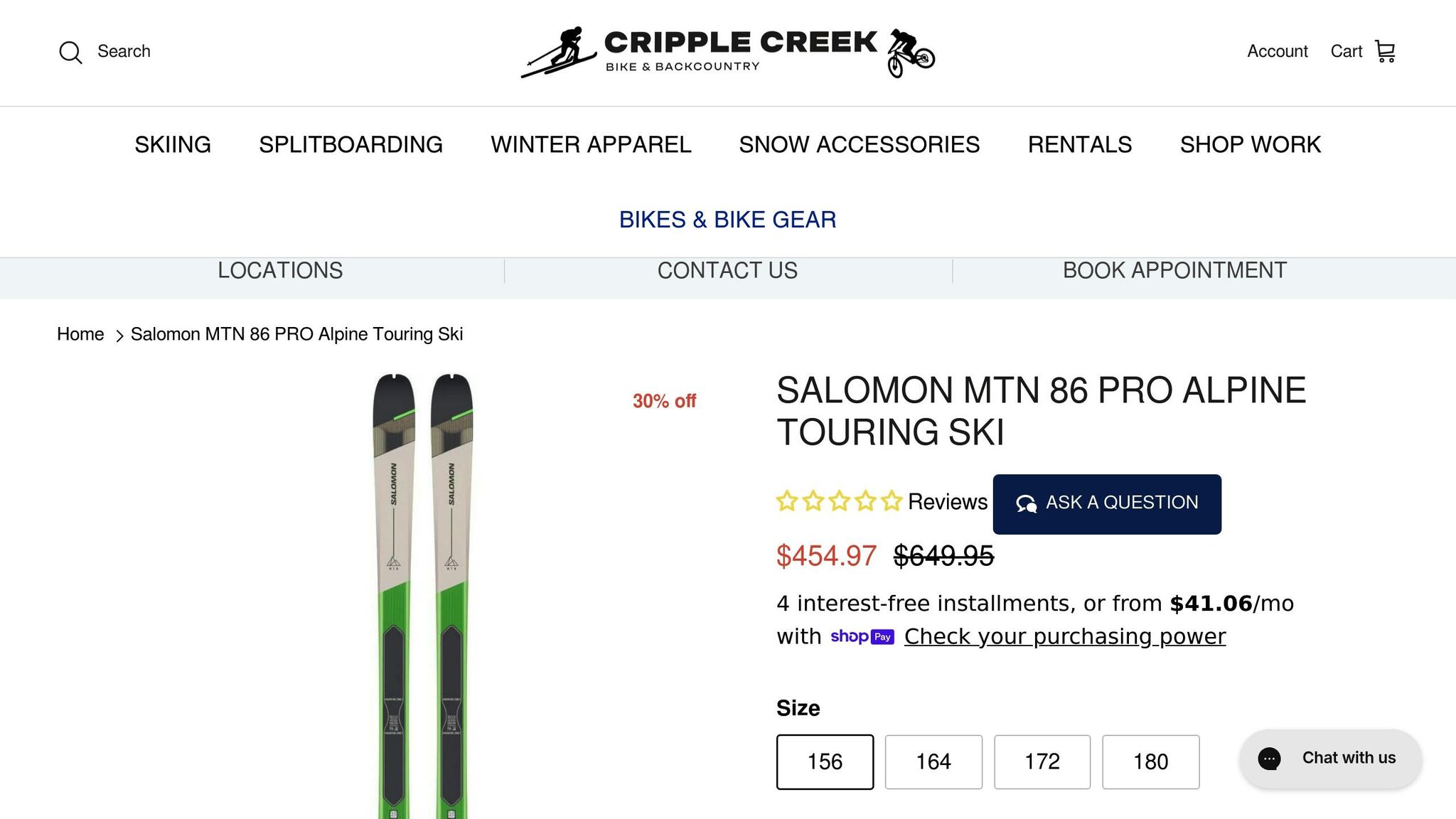
Salomon MTN 86 Pro håller sig till en klassisk design för offpistskidåkning. Medan den levererar pålitlig prestanda i nedförsbacke känns dess traditionella stil något föråldrad jämfört med nyare, mer kompakta alternativ. Låt oss bryta ner hur den står sig i viktiga områden.
Vikt
Även om den är byggd med lätta material, tillför den fullängdsdesignen på MTN 86 Pro extra vikt. Detta gör uppförsbackar mer krävande jämfört med smidigare, moderna alternativ.
Längd
Skidans standardlängder för alpin skidåkning ger utmärkt stabilitet och flytförmåga i djup snö. Detta sker dock på bekostnad av manövrerbarheten, särskilt vid trånga, tekniska uppförsbackar.
Pjäxkompatibilitet
MTN 86 Pro kräver specialiserade alpina turpjäxor och bindningar. Denna uppsättning säkerställer solid kraftöverföring och kontroll i backen men begränsar dess flexibilitet. Fitnessinriktade skidåkare som vill ha utrustning som fungerar med standard vinterpjäxor kan se detta som en nackdel.
Prestanda (Uppför/Nedfärd)
När det gäller uppförsbackar kräver den traditionella designen mer ansträngning, vilket kanske inte tilltalar dem som prioriterar effektivitet. Utförs glänser den däremot – och erbjuder stabilitet och självförtroende, även i blandade förhållanden. Det är en stabil allmountainskida, men om snabba och smidiga uppstigningar är din grej kanske MTN 86 Pro inte är det bästa valet.
Pris
Som en del av premiumkategorin för turåkning kommer MTN 86 Pro med ett högre pris. Utöver själva skidan behöver du investera i specialutrustning, vilket kan bli kostsamt. Med sin robusta konstruktion och utförsegenskaper är den värd det för traditionella alpina turåkare, men de som fokuserar på uppförshastighet och portabilitet kan föredra moderna, kompakta design som Snowfeet*. Dessa nyare alternativ erbjuder ofta bättre smidighet och mångsidighet för fitnessinriktade skidåkare.
För- och nackdelar
Här är en snabb jämförelse av styrkor och kompromisser för varje modell vi har granskat:
| Modell | Pjäxkompatibilitet | Användarvänlighet & Inlärningskurva | Mångsidighet & Portabilitet | Investeringsnivå |
|---|---|---|---|---|
| Snowfeet* WALKSKI | Fungerar med standardpjäxor | Lätt för nybörjare | Superportabel – får plats i vilken vanlig ryggsäck som helst | Budgetvänlig |
| Snowfeet* NORDIC | Fungerar med standardpjäxor | Nybörjarvänlig | Kompakt – perfekt för varierande terränger | Budgetvänlig |
| Atomic Backland 86 UL | Kräver specialiserade alpina turpjäxor (AT) | Mer teknisk; idealisk för experter | Mindre portabel; byggd för aggressiva utförsåkningar | Högre kostnad |
| Blizzard Zero G 105 | Kräver specialiserade alpina turpjäxor (AT) | Avancerad; bäst för erfarna användare | Tyngre uppsättning; fokuserad på utförsåkning | Högre kostnad |
| K2 Wayback 89 | Kräver specialiserade alpina turpjäxor (AT) | Kräver avancerade färdigheter för säker användning | Kluftigare; svårare att transportera | Högre kostnad |
| Salomon MTN 86 Pro | Kräver specialiserade alpina turpjäxor (AT) | Utmanande; designad för erfarna fjällskidåkare | Större uppsättning; mindre lämplig för vardagsanvändning | Högre kostnad |
Varför Snowfeet* sticker ut
Snowfeet* produkter glänser när det gäller portabilitet och användarvänlighet. Deras lätta, kompakta design gör uppförsbackar enklare och eliminerar behovet av dyr, specialiserad alpinturutrustning. Du kan slänga dem i en vanlig ryggsäck och ge dig ut på stigen utan krångel. Dessutom är de nybörjarvänliga, vilket är en stor fördel för alla som är nya inom sporten eller byter från andra vinteraktiviteter.
Traditionella skidor: Byggda för utförsåkningsäventyr
Om utförsåkning är ditt huvudmål ger traditionella alpina turåksskidor seriös stabilitet i branta nedfarter. Deras längre kanter och bredare plattformar är designade för tekniska åk. Men här är grejen: de är tyngre och klumpigare, vilket gör uppförsbackar mer utmanande och mindre effektiva.
Kostnad och tillgänglighet
Snowfeet* produkter balanserar prestanda och prisvärdhet, vilket gör dem till ett smart val för skidåkare som värdesätter tillgänglighet. Å andra sidan kräver traditionella turåksskidor en större ekonomisk investering på grund av deras specialiserade utrustning. Denna kostnadsskillnad hänger också ihop med användbarheten – Snowfeet* modeller är lättare att lära sig och bära, medan traditionella uppsättningar kräver mer skicklighet och ansträngning.
Inlärningskurva och portabilitet
För nybörjare eller de som vill ha en smidig övergång från andra vintersporter erbjuder Snowfeet* en mjuk inlärningskurva. Deras kompakta storlek och lätta natur gör dem enkla att transportera och använda. Traditionella alpina turåkningsskidor, även om de levererar utförskraft, kräver mer teknisk kunskap och är svårare att släpa på. Dessa faktorer gör Snowfeet* till ett förstahandsval för många moderna skidåkare som prioriterar mångsidighet och bekvämlighet.
Att göra ditt val
I slutändan handlar allt om vad du värdesätter mest. Om du söker bekvämlighet, prisvärdhet och en lättanvänd setup för uppförsträning eller avslappnad skidåkning är Snowfeet* ett stabilt val. Men om du jagar topp utförsprestanda och inte har något emot att investera i en mer avancerad, teknisk setup, kan traditionella alpina turåkningsskidor vara ett bättre alternativ.
Slutsats
Snowfeet* produkter är ett utmärkt val för skidåkare som söker portabilitet, prisvärdhet och mångsidighet. De kan spara dig upp till 78 % jämfört med traditionella skidset, som vanligtvis kostar runt 2 200 dollar. Och det bästa? Du behöver inte kompromissa med prestandan för de flesta fritidsskidåkningar.
Dessa kompakta skidor är särskilt tilltalande för fitnessentusiaster. Med längder på bara 100 cm och 90 cm gör de uppförsbackar enklare och hjälper till att minska trötthet under längre pass. Dessutom innebär den universella frihälbindningen att du inte behöver investera i specialiserade alpina turpjäxor.
För skidalpinister utmärker sig Snowfeet* genom sin portabilitet. Till skillnad från traditionella turåkningsskidor som kräver skrymmande utrustning, kan dessa kompakta skidor enkelt glida ner i en vanlig ryggsäck. Deras kortare längd gör dem också lättare att hantera i trånga utrymmen och på svår terräng.
Medan traditionella alpina setup som Atomic Backland 86 UL och Blizzard Zero G 105 är svåra att slå när det gäller utförskraft, erbjuder Snowfeet* ett praktiskt alternativ för de flesta amerikanska skidåkare. Om du söker tillgänglighet, enkel inlärning och förmågan att hantera olika terränger, hittar Snowfeet* en stabil balans mellan prestanda och bekvämlighet.
Vanliga frågor
Hur skiljer sig Snowfeet* skidor från traditionella alpina turåkningsskidor?
Snowfeet* skidor ger något nytt med sin små storlek, lätta konstruktion och allsidiga användbarhet. Medan traditionella alpina turåkningsskidor ofta är designade för specifika ändamål – som att åka i skidorten eller ta sig an fjällstigar – är Snowfeet* skidor byggda för att klara nästan vad som helst. Oavsett om du cruisar nerför backar, utforskar vandringsleder eller leker i en snowpark, har dessa skidor dig täckt. Dessutom gör deras kompakta design dem superportabla och lätta att hantera, vilket gör dem till ett utmärkt val för träningsvarv eller till och med skidalpinistiska äventyr.
Till skillnad från traditionella turåkarskidor, som vanligtvis kräver specialiserade bindningar och pjäxor (och all extra tyngd som följer med dem), håller Snowfeet* skidor det enkelt. De är lättare, enklare att använda och glänser när det gäller att klättra uppför och behålla kontrollen på vägen ner. För friluftsälskare som vill ha utrustning som är flexibel och presterar bra utan extra vikt eller komplexitet är Snowfeet* skidor ett utmärkt val.
Hur jämför sig Snowfeet* skidor med traditionella längre skidor i olika snöförhållanden?
Varför Snowfeet* Skidor sticker ut
Snowfeet* skidor ger en fräsch twist till skidåkning och presterar imponerande i olika snöförhållanden. Deras kompakta, lätta design gör dem enkla att hantera, oavsett om du cruisar på preparerade spår, flyter genom pudersnö eller tar dig an blandad terräng. Den kortare längden ger dig bättre smidighet och balans, vilket gör dem idealiska för allt från träningsvarv till skidmountainbike-äventyr.
Traditionella skidor är ofta byggda för hastighet och stabilitet på preparerade backar, men de kan kännas klumpiga och begränsande. Snowfeet* skidor, å andra sidan, glänser med sin mångsidighet. De låter dig göra snabba, skarpa svängar och erbjuder överlägsen kontroll, särskilt när snön blir oförutsägbar. Om du letar efter ett mer dynamiskt och tillgängligt sätt att åka skidor på – utan att ge upp prestanda – är dessa skidor en riktig game-changer.
Är Snowfeet* skidor ett bra val för nybörjare och avancerade skidåkare, och vad bör varje grupp tänka på när de väljer dem?
Ja, Snowfeet* skidor är ett utmärkt val för skidåkare på alla nivåer tack vare deras lätta och kompakta design. För nybörjare fungerar kortare modeller (runt 38–50 cm) bäst. De är lättare att kontrollera, vilket gör det mycket mindre skrämmande att lära sig grunderna på mjuka backar. Dessutom hjälper de till att bygga självförtroende utan tyngden från traditionella skidor.
För erfarna skidåkare erbjuder Snowfeet* skidor oöverträffad portabilitet och smidighet. De är perfekta för snabba svängar, träningsvarv eller till och med för att utforska backcountryleder. Med det sagt, om du jagar höga hastigheter eller tar dig an djup pudersnö kan traditionella skidor fortfarande vara det bättre alternativet. Men överlag hittar Snowfeet* skidor en utmärkt balans mellan bekvämlighet och prestanda, vilket gör dem till ett roligt och mångsidigt val för alla skidåkare.














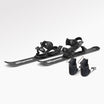






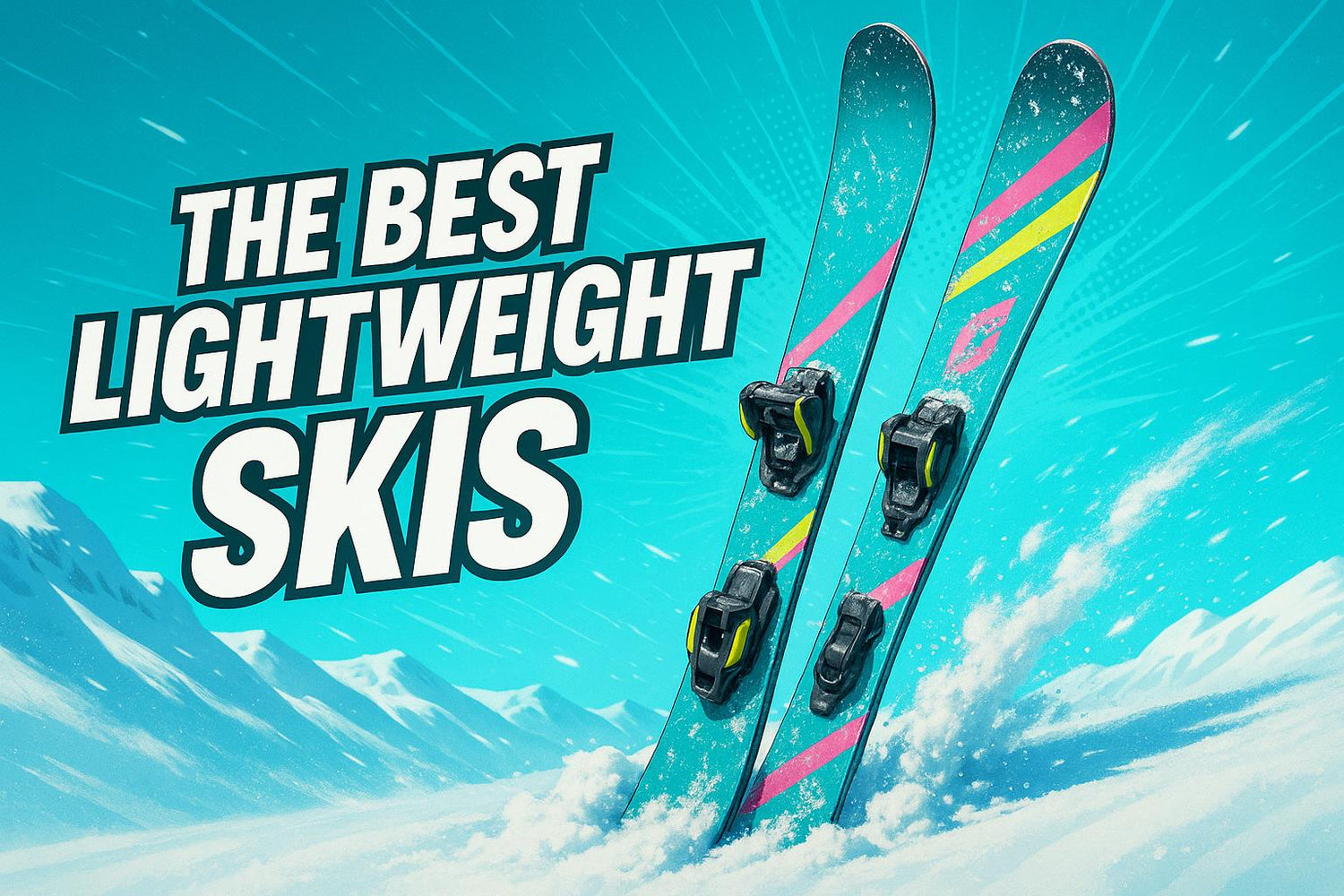
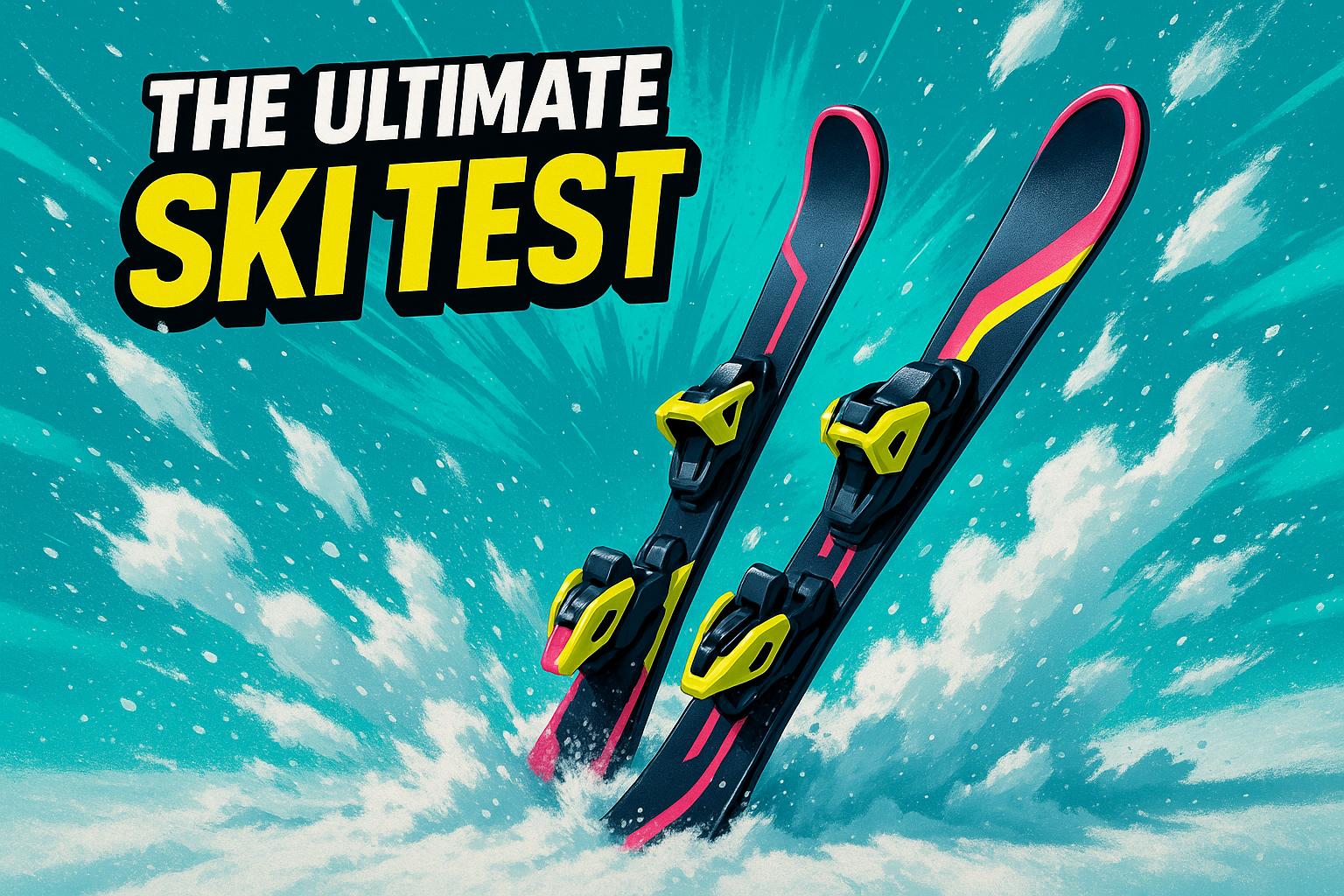
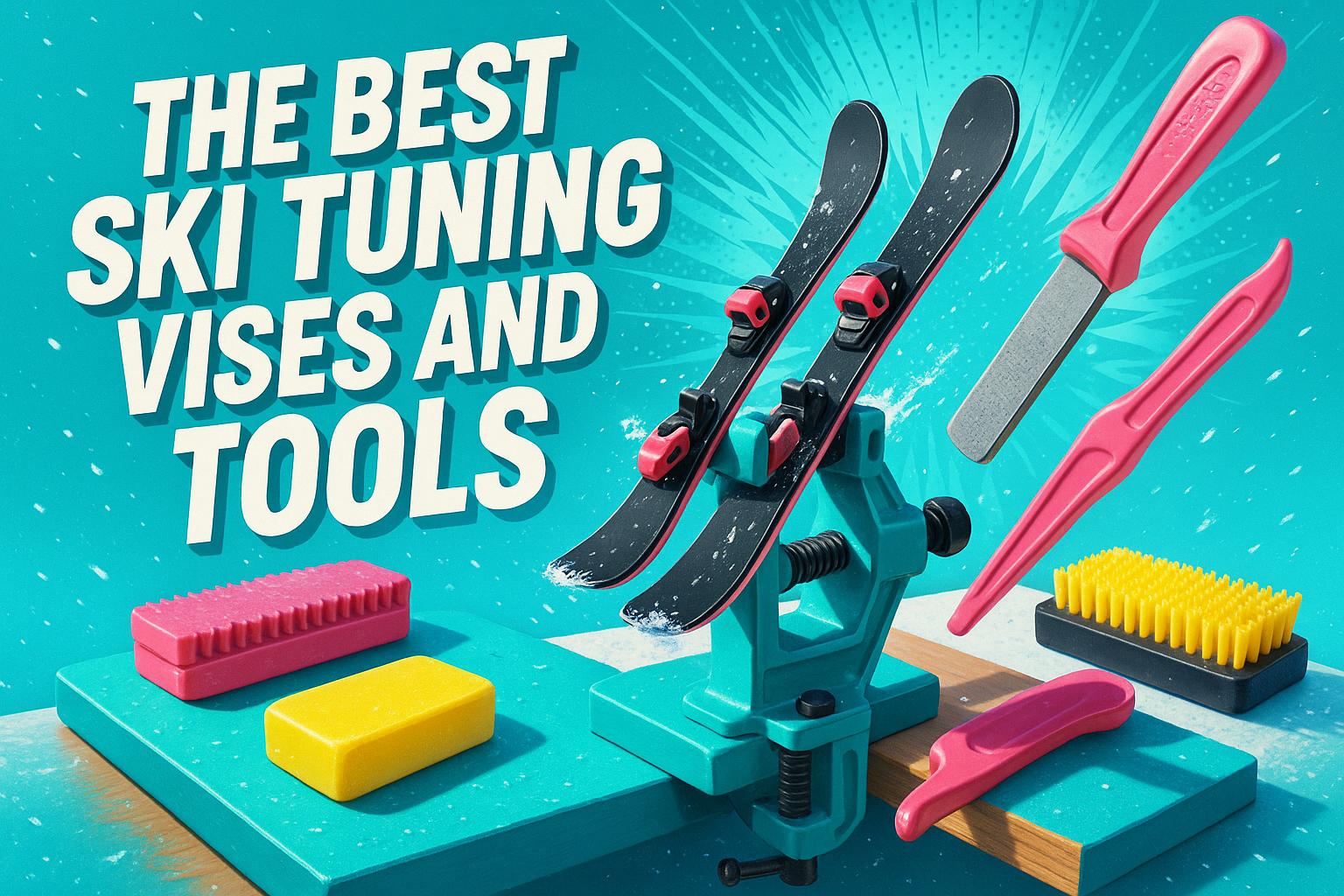










Lämna en kommentar
Denna webbplats är skyddad av hCaptcha och hCaptchas integritetspolicy . Användarvillkor gäller.